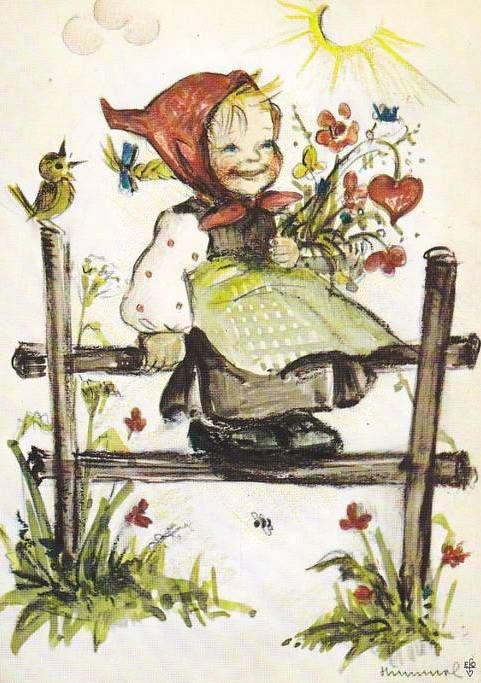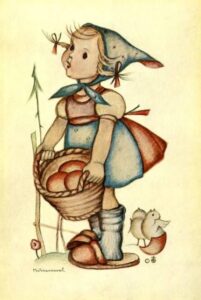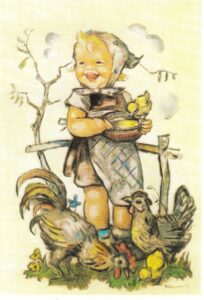Learn more about the woman behind the figurines
The power of her drawings lies in the way she captured the inner honesty of the young.
The early days (1909-1915)
Berta Hummel was born on May 21, 1909 in the city Massing located in southern Bavaria, the third daughter of Adolf Hummel, a well-to-do merchant, and his wife Victoria Hummel. Her mother remarked when the blue-eyed Bertl, as she was affectionally known, was yet a teenage that she was always interested in drawing.
Education (1915-1931)
On May 1, 1915, at the age of five just before her sixth birthday, she began school in Massing conducted by the Poor School Sisters.
On May 2, 1921, three weeks before her twelfth birthday, she enrolled in the Sinbach/Inn to Mariam Heights.
She studied at Academy of Applied Art in Munich taking the entrance test without preparation on April 25, 1927 and tested second best even though she was one of the youngest to take the test. With access to the leading artists and teachers in the area, she received the proper training she sought out with oil painting, fabric weaving and clothing design which she would put to good use later. It was here she met two Franciscan nuns, Laura and Kastka, from the Sießen Convent and later lived in the same house on Blumen Strasse at the Sisters of the Holy Family. Bertl, as she was then called, at the age of 18, took her finals on March 15, 1931 and passed with an A as well as having the best in the entire class.
Did You Know: Adolf Hitler applied to the same Academy of Applied Art in Munich and was turned down twice.
Political Unrest (1929-1931)
In 1929, the National Socialist Party led by Adolf Hitler made promises of employment and economic stability which was enticing for many due to the worldwide Depression which hit Germany especially hard. The positive impression the two Sisters had on her prompted her to enter the Order of Saint Francis on April 22, 1931 as a Candidate soon after completing her studies in Munich. She found that it was difficult to leave the city of Munich with its beautiful architecture, monuments and art treasures in the Pinakothek, Glyptothek, and State Gallery.
Early Days in the Sießen Convent (1930-1934)
August 14, 1930, Berta Hummel, age 21, visited the Convent Sießen to ask permission to join the community of Sisters.
August 22, 1933 became a postulant, forsaking her name Berta and was officially known as Sister Maria Innocentia Hummel, O.S.F. (Order of Saint Francis).
In 1933, the Sisters staged an exhibit in a nearby town of Sister Hummels sketches. A letter with proofs of her work were sent to the publishing company in Munich, Ars Sacra Josef Mueller Verlag. They in turn requested more sketches to publish and eventually led to thirty-seven Hummel pictures in the form of postcards, communion souvenirs and merit pictures for students.
She was permitted to continue her career as an artist at the Sießen Convent and in 1934, her “Hummel Buch” with poems by the Viennese writer Margarete Seemann appeared having been printed and produced by the printing house Emil Fink Verlag in Stuttgart and limited to a total of 5,000 books.
She was 25 when she was professed on August 30, 1934 and was ordained Sister Maria Innocentia Hummel of the Sisters of the Third Order of St. Francis where she shed her white veil and received the black veil. She gave her vows for three years and on August 30, 1937, she gave her everlasting vows of a lifetime of service to God and mankind.
The Infant of Krumbad (1934)
The figurine HUM 78 – Blessed Child, also incorrectly known as The Infant of Krumbad was actually created by Sister Maria Innocentia herself according to the Convent Sießen. In 1934, His Eminence, Johannes Babtista Sproll was the Archbishop of Rottenburg, Germany and had jurisdiction over the Convent Sießen. He was banished by the Nazis from his Diocese and Rottenburg and Bishop seat and was forced to hide out in many different Convents and Cloisters. Most of the time he stayed at the Benedictine Convent of Saint Ottilien, Bavaria or in the Convent Krumbad. Sister Maria Innocentia had the Goebel Porzellan Fabrik sculpt a special Christ Child modeled after a drawing she had created. She then painted it and took it to Krumbad as a gift for His Eminence Archbishop Sproll. He returned to Rottenburg after the war but the Christ Child stayed in Krumbad. This infant is actually not the same as HUM 78 – Blessed Child but was also modeled after another drawing.
Did you know: HUM 420 – Is It Raining? is actually from a drawing of Archbishop Johannes Babista Sproll as a child on his way to and from school in the rain reading from one of his school books placed in the spokes of his umbrella.
Political unrest (1933-1939)
The political events in Germany began to take a different path due to the dissolving economy and this had a negative effect on the Convent. Even Sister Maria Innocentia was publicly redressed directly by Adolf Hitler. In a March 20, 1937 newspaper article by “The SA-Man”, there was criticism for a piece of art she created some time between 1933 and 1935 in charcoal and pastel called H 655, Volunteers, Lieb’ Faterland magst ruhig sein! or translated in English, Dear Fatherland, May You be at Peace which was written at the foot of the drawing. The magazine, “Hochland” even spoke of heresy.
This is now reflected in the HUM 50 – Volunteers figurine. A young man who had just been drafted into the army wanted to meet the Sister. She accidently met him in the hallway of the Convent and not having seen a soldier yet, she inquired as to how the buckle closed and which side the gun-belt was worn. She made the sketch from seeing this young man that day.
There was also in this newspaper article written which described the artwork of Sister Hummel as “Charcoal drawings, depicting so called “Children’s scenes”; numerous modified drawings of the same epitome, of the same genre of children, with hydrocephalic heads and club feet, and because of their sense of “inner humor” are always drawn with coat hangers sticking out from their frocks and tongues hanging out of unlaced, torn boots.”
Sister Maria Innocentia Hummel also authored a second book in 1939 with the title “Hui die Hummel” printed by Ars Sacra, Verlag Josef Mueller in Munich. She was also to write texts for the volume planned by Ars Sacra but she became so seriously ill that her responsibilities were taken over by the Munich writer Joseph Bernhart. Ars Sacra took their time and put together the best of Berta Hummels creative work. Herr Bernhart chose the book’s title, “Hui, die Hummel” which translates to Here Comes the Bee which was a pun on the artist’s name.
From Postcard to Figurine (1934-1935)
The co-owner of the W. Goebel Porzellanfabrik near Coburg, Franz Goebel, had traveled to Munich to make contact with potential customers during Advent 1933, and came across postcards with Hummel motifs printed by Ars Sacra and saw great potential for the nun’s simplistic sketches to become a much-desired line of figurines. It was love at first sight that led to a contract with the artist in 1934. On January 9th, 1935, Franz Goebel and the Sießen Convent realized an agreement to have his company, W. Goebel Porzellanfabrik handcraft each figurine with the highest quality standards. Sister Hummel insisted that the designs were to remain true to the original artwork and that she would have final artistic control of each. The Convent worked with Sister Hummel with the designs and would approve or disapprove every figurine design before production would begin. Each figurine was to have the M I Hummel signature incised somewhere on the figurine to prove its authenticity.
The first public display of the new M.I. Hummel figurines was in 1935 at the Leipzig Fair international trade show and was met with instant appeal from those in attendance. This made a hit at a time when the child star Shirley Temple was just beginning and America was in love with the innocence that children displayed. The very early samples of the figurines had the letters FF incised on the bottom of which only a few are known to exist today. Shortly after, the Goebel logo of the Crown was used as it could be seen on the company’s many other products.
The German Nazis take over the Convent (1940-1944)
In October of 1940, the convent at Sießen was confiscated by the Nazis and turned it into a camp for Germans brought back home from foreign countries. and the Sisters were told they had to evacuate within ten days. On November 4, 1940, evacuation of the Convent Sießen by order of the regime was officially declared. Only a few rooms were left to the Sisters while the rest of the area was being occupied by government officials. There were 250 of the community that had to leave the convent and look for shelter elsewhere. Sister Innocentia removed to her parent’s home in Massing but on November 30, 1940, longing for the stillness and sanctity of the convent, she returned to the Sießen Convent. It was there that she shared the poverty and hardships of the forty Sisters that had remained. She labored incessantly in a little cell that served as both her bedroom and her studio. Her room was now in the cold and damp basement which contributed to a decline in her health. It was here that she finished two designs for an alter of a church in Bavaria and portraits of children continued to be drawn in the short periods of time she had each day.
Becoming ill (1944-1946)
During August of 1944, Sister Maria Innocentia came down with pleurisy. She was first taken to a hospital at Isny and then later to Wangen in Allgäu. From November 8, 1944 to April 12, 1945 she resided in Isny at a sanatorium with a diagnosis of tuberculosis. She improved steadily and on April 12, 1945 she returned to Sießen. On July 19, 1945 she had a relapse of her illness and on September 18, 1945 she was admitted to the Sanatorium for Children in Wangen in Allgäu again. On top of everything else, she contracted jaundice. It wasn’t until the next year on September 9, 1946 that she returned to the Convent Sießen but her condition deteriorated rapidly once again from November 1, 1946.
Death
Five days later, she died a young but fruitful life on November 6, 1946 of tuberculosis at the age of 37. During her funeral, snowflakes fell and covered the earth with a white coat. Soon after the funeral, the sun came back out. She was interment at the graveyard of the Convent Sießen on November 9, 1946.
After her Death
The following is part of an undated, news-release of the life of Sister Hummel after her death. It was written by the Venerable Sister Gonsalva Wiegand, O.S.F who was also the author of the book Sketch me Berta Hummel. “Of all the American buyers who were charmed by those figurines, only one ordered them at the Leipzig-fair. The others thought that they were too expensive to sell, But the moment they appeared in the United States, they became a sensation. Thereafter, throughout the war and the precarious peace that followed, it was impossible to meet the demand not only for Hummel figurines, but for Hummel prints and Hummel Christmas cards and anything Hummel at all.”
There is a page of the history of the M.I. Hummels available to provide you with dates on her short but fruitful life during the 20th century’s darkest days.
About Sister Maria Innocentia Hummel
M. I. Hummel History
![]() I’ve always been interested in the history involving the creation of the M.I. Hummel figurines. In learning the history of these high quality porcelain items, you learn to appreciate them all the more when you realize what it takes to create just one. Visit the History Calendar.
I’ve always been interested in the history involving the creation of the M.I. Hummel figurines. In learning the history of these high quality porcelain items, you learn to appreciate them all the more when you realize what it takes to create just one. Visit the History Calendar.
Updated 5 June 2021


